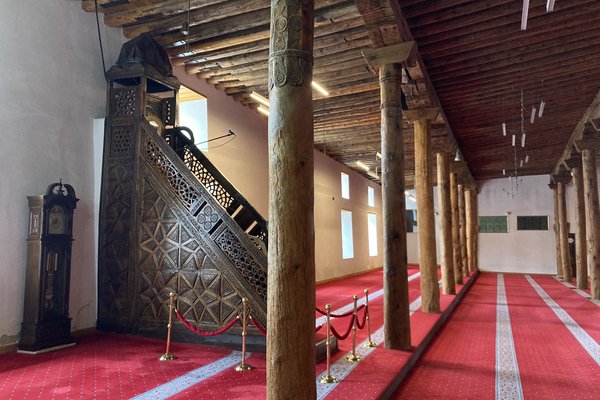Turkiye
Wooden Hypostyle Mosques of Medieval Anatolia
The Wooden Hypostyle Mosques of Medieval Anatolia show the development of a specific type of wooden architecture.
The use of wood in mosques was brought from Central Asia to Anatolia in the 11th century. The interiors of the mosques are characterized by wooden posts, a timber ceiling and wooden carvings. They also have colorful geometrical and floral paintings.
Community Perspective: the site consists of five mosques in different towns, even different provinces. Mahmut Bey Mosque, Eşrefoğlu Mosque, Arslahane Mosque and Sivrihisar Mosque so far have been reviewed and are seen as worthy only of a slight detour.
Site Info
Official Information
- Full Name
- Wooden Hypostyle Mosques of Medieval Anatolia (ID: 1694)
- Country
- Turkiye
- Status
-
Inscribed 2023
Site history
History of Wooden Hypostyle Mosques of Medieval Anatolia
- 2023: Advisory Body overruled
- ICOMOS advised Referral for mgt issues
- 2023: Name change
- Upon inscription, at the suggestion of ICOMOS: from "Medieval Mosques of Anatolia with Wooden Posts and Upper Structure" to "Wooden Hypostyle Mosques of Medieval Anatolia"
- 2023: Inscribed
- Inscribed
- Type
- Cultural
- Criteria
- ii
- iv
Links
- UNESCO
- whc.unesco.org
All Links
UNESCO.org
- whc.unesco.org — whc.unesco.org/
Community Information
- Community Category
- Religious structure: Islamic
Travel Information
Ankara Hotspot
Recent Connections
-
Derived from more than one TWHS
The three mosques had separate T List e… -
Ankara Hotspot
Arslanhane Mosque lies in Ankara -
Seljuk Empire
"High officials of the Seljuk sultanate…
Connections of Wooden Hypostyle Mosques of Medieval Anatolia
- Geography
-
-
Located in a Capital City
Arslanhane Mosque lies in Ankara, the capital of Turkey
-
- History
-
-
Seljuk Empire
"High officials of the Seljuk sultanates, chiefs of the beyliks, emirs, and wealthy merchants often patronised the construction of mosques that were smaller than the grand-scale stone and brick counterparts constructed by the sultans." (AB ev)
-
- Architecture
-
-
Octagons
"The Ahi Şerefeddin Tomb is located next to the Arslanhane Lodge. It has an octagonal pyramidal cone that sits atop an octagonal drum, which in turn sits on a square base" (AB ev) -
Wooden architecture
"The mosques have a structural system whereby the exterior envelopes are of masonry but the rows of columns (hypostyle) that support the flat ceilings and the roofs are all of wood" (AB ev) -
Muqarnas
"wooden muqarnas (three-dimensional “honeycomb” Islamic decorations) .. form the capitals of columns" (AB ev) -
Spolia
"stone spolia (repurposed architectural fragments) form the capitals of columns" (AB ev)
-
- World Heritage Process
-
-
Derived from more than one TWHS
The three mosques had separate T List entries + one as a group
-
- Religion and Belief
-
-
Notable mosques
Includes 5 mosques noted for their wooden interior.
-
- Constructions
-
-
Tombs
Included with the mosques are some tombs, such as Süleyman Bey's Tomb, and the Half Tomb (Ottoman Tomb) (at Eşrefoğlu Mosque) and Ahi Şerefeddin Tomb (at Arslanhane)
-
- Timeline
-
-
Built in the 13th century
"built in Anatolia between the late 13th and mid-14th centuries" (AB ev)
-
- WHS Hotspots
-
-
Ankara Hotspot
Arslanhane Mosque lies in Ankara
-
- WHS Names
-
-
Name changes
Upon inscription, at the suggestion of ICOMOS: from "Medieval Mosques of Anatolia with Wooden Posts and Upper Structure" to "Wooden Hypostyle Mosques of Medieval Anatolia"
-
News
No news.
Recent Visitors
Visitors of Wooden Hypostyle Mosques of Medieval Anatolia
- Afshin Iranpour
- Alexander Barabanov
- Alexander Lehmann
- A. Mehmet Haksever
- Astraftis
- Atila Ege
- Bill Koo
- Bill Maurmann
- Bin
- Can SARICA
- Corinne Vail
- Dimitar Krastev
- Els Slots
- Evgenii
- Fan Yibo
- George Gdanski
- Hadrianus
- Harry Mitsidis
- henryjiao18
- Hubert
- Ivan Rucek
- Janos
- Jan-Willem
- Javier Coro
- Jeffrey Chai
- Juha Sjoeblom
- La Concy
- Lado Joel
- Loic Pedras
- Lucio
- Lukasz Palczewski
- Maciej Gil
- Martina Rúčková
- michaelsballard
- MichaelStro
- Miloš Tašković
- Nick M
- Nihal Ege
- palka25
- Patrik
- Paul Schofield
- Randi Thomsen
- Roger Ourset
- Roman Bruehwiler
- Solivagant
- Stanislaw Warwas
- Svein Elias
- Tarquinio_Superbo
- Thomas Buechler
- Thomas van der Walt
- Tim Allen
- tony0001
- Tony H.
- Westwards
- Wojciech Fedoruk
- Yevhen Ivanovych
- Zoe
- Zoë Sheng
- Zos M
Community Reviews
Show full reviewsZoe
Wooden Hypostyle Mosques of Medieval Anatolia
Wooden Hypostyle Mosques of Medieval Anatolia (Inscribed)
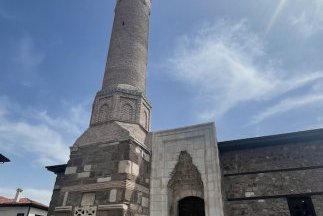
I recently visited Aslanhane Mosque (in Turkish, Arslanhane Camisi) in Ankara as I was already in the city for the day due to a flight connection. This Seljuk mosque, built in 1290 CE, seems to be a lot smaller and less interesting than the other locations of this WHS. Thus, I wouldn't recommend it as a stop to anyone besides WHS travelers. I have seen a lot of Seljuk mosques/madrasahs, of comparable age, that are more stunning and visually intriguing during my time in Turkey (the Çifte Minareli Madrasah in Erzurum, built 1265 CE, if you want a rec)! However, what makes these hypostyle mosques interesting are the wooden beams inside, thought to have originated from the Mongol invasions half a century prior, according to UNESCO. When you arrive, there is a small plaque explaining the mosque's significance in Turkish only. In summary, Aslanhane mosque is near the historical area of Ankara, and if you are already visiting those sites, it is worth a short detour. However, I don't think I would recommend it for anyone farther away.
Keep reading 0 commentsEls Slots
Wooden Hypostyle Mosques of Medieval Anatolia
Wooden Hypostyle Mosques of Medieval Anatolia (Inscribed)
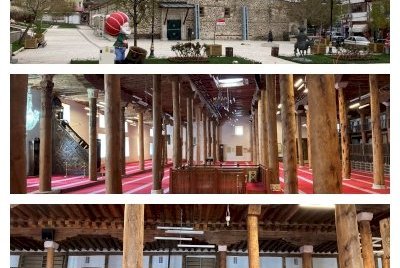
The Great Mosque of Sivrihisar is both a stand-alone entry on Turkey’s Tentative List and one of the locations of the five Wooden columned and wooden roofed mosques in Anatolia. It can be easily visited along the way from Iznik to Gordion, as the road passes the town. The mosque stands proudly at the main square, surrounded by a 14th-century mausoleum, an Ottoman clock tower, and some statues of a turbaned man which I think represent the local folklore character Nasreddin Hodja (who has his own spot at the UNESCO Intangible Heritage List).
The mosque dates back to the 13th century, as attested to by stone inscriptions above the gates. It is still in use as a mosque, so you have to take off your shoes and female travellers should keep their headscarves ready. An explanation in English about its history can be found next to the main gate. Not much natural light enters the building, you can switch on the electric lights yourself after entering to better be able to admire the decoration.
The use of wooden poles as a bearing system for the roof of a mosque was a Seljuk innovation. The number used in Sivrihisar (67) was exceptionally large. Wood is also used in the ceiling and as a dividing mechanism for the women’s section. Superficially they just look like bare poles, but some of them are finely decorated with flowers and motifs at the top. A few column heads even have spolia: …
Keep reading 0 commentsZoë Sheng
Wooden Hypostyle Mosques of Medieval Anatolia
Wooden Hypostyle Mosques of Medieval Anatolia (Inscribed)
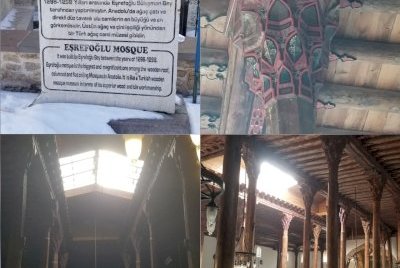
Although the most obvious visit may seem the mosque in Ankara I wanted to do as little as necessary in the capital. While road tripping I visited the Hittite spring nearby Eşrefoğlu Mosque but even with two sites to visit it hardly makes it worth a side trip, especially 2h from Konya and back doesn't seem worth it at all.
The laid-back town has almost no traffic and plenty of parking around the mosque. There is a sign for prayer but it was open and not a soul inside. Like most bigger mosques in Turkey there is a woman's section leading around the back and and up to the balcony, which I'll refer to as the VIP seats to make myself feel better about it.
As there was nobody in the mosque I took some pics from the entrance before ascending. In this case the roof can be seen better from up there anyway.
While I think the craftsmanship is solid and well done, I don't think they quite have the same class of wooden churches in Eastern Europe, and I'm not entirely sure how re-roofed these are now. It's been over 700 years since they were built and I can't see these wooden beams being original.
Keep reading 0 commentsWojciech Fedoruk
Wooden Hypostyle Mosques of Medieval Anatolia
Wooden Hypostyle Mosques of Medieval Anatolia (Inscribed)
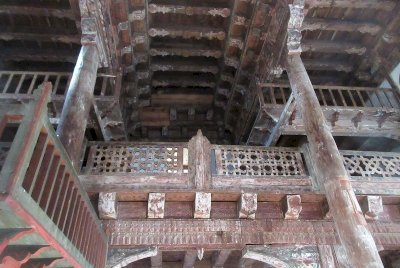
We visited Mahmut Bey mosque on the way from Safranbolu to Kizilirmak delta (a 2019 nomination that was withdrawn by Turkey after negative ICOMOS evaluation). It needed a short detour to the rural area of Kasaba where the mosque is located. It was around 6pm and the mosque was already closed but the guardian spotted us on the way and returned to open it just for us. It was very fortunate as from the outside the mosque is not special. It is its iterior that is particularly beautiful and interesting.
The mosque was built in XIVth century. No cement was used (except for mihrab) and the roof was built without any metal. So the inside is entirely wooden, with beautiful paintings. I am not aware how many original elements survived but overall it looked very old. Turkey has not publicly revealed any plans to inscribe the mosque* but… UNESCO plaque is already there! Not WHS plaque and they admit it is on tentative list only, but still I find it misleading.
*written in 2019. In 2023 the mosque was inscribed as a component of serial nomination 'Wooden Hypostyle Mosques of Medieval Anatolia'.
Keep reading 0 comments
